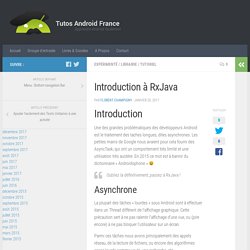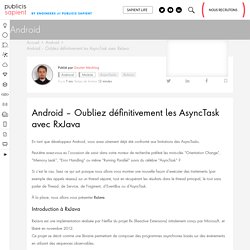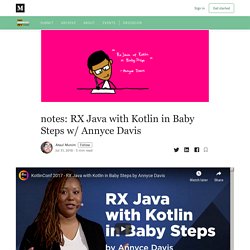

Programmation Kotlin Réactive Avec RxJava et RxKotlin. Proandroiddev. When RxJava came to the world the Event bus pattern implementation becomes much easier, but we still need to write abstraction on top of the RxJava to make type safety API for our EventBus.

First of all, create an EventBus interface. EventBus A class implements the BusEvent interface to indicate EventBus event. Queue For each type of event, we need to create Queue . The consumeReplayQueue method fire cached event and clear stream by publishing internal IdleEvent that will be filtered. Stream To get stream we need to call queue the method of EventBus interface and passe one of the queues that we created earlier. And finally a quick example of how to use out EventBus: with replay stream Thanks for the reading, all code you can find here. The introduction to Reactive Programming you've been missing. The introduction to Reactive Programming you've been missing (by @andrestaltz) This tutorial as a series of videos If you prefer to watch video tutorials with live-coding, then check out this series I recorded with the same contents as in this article: Egghead.io - Introduction to Reactive Programming.

So you're curious in learning this new thing called Reactive Programming, particularly its variant comprising of Rx, Bacon.js, RAC, and others. Learning it is hard, even harder by the lack of good material. Rx.Observable.prototype.flatMapLatest(selector, [thisArg]) Projects each element of an observable sequence into a new sequence of observable sequences by incorporating the element's index and then transforms an observable sequence of observable sequences into an observable sequence producing values only from the most recent observable sequence. Holy cow. I've read two books, one just painted the big picture, while the other dived into how to use the Reactive library. Request and response.
Introduction à RxJava - Tutos Android France. Une des grandes problématiques des développeurs Android est le traitement des taches longues, dites asynchrones.

Les petites mains de Google nous avaient pour cela fourni des AsyncTask, qui ont un comportement très limité et une utilisation très austère. En 2015 ce mot est à bannir du dictionnaire « Androidophone » Android - Oubliez définitivement les AsyncTask avec RxJava - Publicis Sapient Engineering - Engineering Done Right. En tant que développeur Android, vous avez sûrement déjà été confronté aux limitations des AsyncTasks.

Peut-être avez-vous eu l’occasion de saisir dans votre moteur de recherche préféré les mots-clés "Orientation Change", "Memory Leak", "Error Handling" ou même "Running Parallel" suivis du célèbre "AsyncTask" ? Si c’est le cas, lisez ce qui suit puisque nous allons vous montrer une nouvelle façon d’exécuter des traitements (par exemple des appels réseau) sur un thread séparé, tout en récupérant les résultats dans le thread principal, le tout sans parler de Thread, de Service, de Fragment, d’EventBus ou d’AsyncTask.
À la place, nous allons vous présenter RxJava. Introduction à RxJava RxJava est une implémentation réalisée par Netflix du projet Rx (Reactive Extensions) initialement conçu par Microsoft, et libéré en novembre 2012. Rx est basé sur le paradigme de la programmation réactive fonctionnelle (Functional Reactive Programming) …Et concrètement… ? RxFlux Android Architecture. This is the first article about the new… This is the first article about the new RxFlux framework.

Is small light-weight framework that makes it easy to follow the Flux pattern with RxJava functionalities. I will not get into the details on how Flux works, in order to understand more how to use Flux pattern in Android, @lgvalle created a nice example and explanation. I would recommend to read it before. In this article I will explain how to create an app from scratch using RxFlux. If you want to see more specific details in how to use RxFlux, go to the repo. Please take the sample app in the repo as a reference. Learning RxJava (for Android) by example. Android Kotlin - RxJava Intro.
RxJava for Kotlin by Viacheslav Okolitiy (Rus) Notes: RX Java with Kotlin in Baby Steps w/ Annyce Davis. (2:40) RX is about programming with asynchronous data streams.

These streams can come from anywhere: user click events, push notifications and GPS updates for example. (4:45) You can use RX in many places. Even if there’s only one event (e.g. a response from a network request), many events (e.g. user typing in a text field), or an error (such that you get zero data events) — they can all be modelled as asynchronous data streams. (6:15) RX is a tool that facilitates lots of things, including: chaining — start operations based on the result of an earlier operationthreading — schedule work and delivery of events on different threads without much effortcomposition & data transformation — combine smaller functions together to achieve goals (8:45) It’s similar to code you’ll see in Kotlin. This example in Kotlin demonstrates some standard operators.
Conversely, RX waits until there’s a subscriber, and applies operations on each emission as and when they come (“lazy”). Creating Observables - Getting Started with RxKotlin in Android - raywenderlich.com. Programmation Kotlin Réactive Avec RxJava et RxKotlin. Introduction to RxKotlin in Android - Hello RxKotlin! - raywenderlich.com.